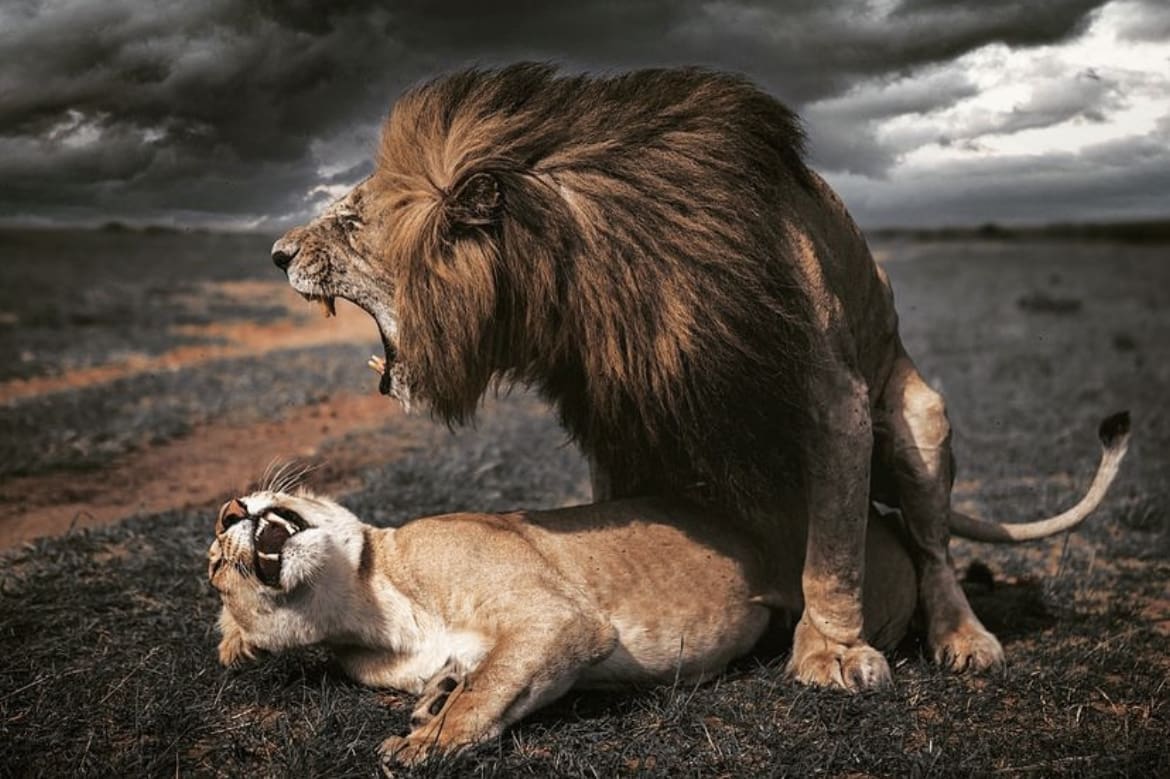Lions are often seen as the rulers of the savannah—powerful, strategic, and relentless. That reputation holds true, even when it comes to their mating habits. If you’ve ever come across footage of lions mating, the sheer intensity of it is hard to ignore. A single pair can mate dozens of times in just one day, and lionesses often take multiple partners during their fertile window.
But there’s more to this behavior than meets the eye. Lions don’t mate excessively out of chaos or randomness. Their extreme mating habits are about survival, genetics, and ensuring the future of the pride. It’s one of nature’s most clever designs.

The Mating Habits of Lions
Relentless Mating Frequency
Lions are not casual when it comes to reproduction. Once a lioness enters her fertile period, mating becomes the only priority. For the next 3 to 5 days, a single lion pair can mate up to 50 times in 24 hours. Each mating session is surprisingly short, lasting just 10 to 20 seconds. Then, after a brief rest, they start again—sometimes every 20 to 30 minutes.
During this time, survival takes a backseat. Lions don’t hunt, eat, or defend their territory with the same focus. Mating becomes an all-consuming task.
Wildlife experts point to the urgency behind this behavior. Female lions have short fertility windows. To increase the chances of conception, lionesses push for frequent mating, no matter how exhausting it becomes for both partners.

Female Lions Drive the Process
Lionesses are not passive participants. In fact, they control when, where, and how often mating happens. Unlike other species where males dominate the process, female lions decide the pace.
This is due to their reproductive biology. Lionesses are polyestrous, meaning they have multiple fertility cycles throughout the year. During these cycles, their bodies signal an urgency to reproduce. They initiate mating and often mate with multiple males in the pride’s coalition over a few days.
As one wildlife biologist explains:
“For lionesses, every second counts. Missing that short fertility window means missing a chance to produce the next generation.”
This behavior may seem excessive, but it serves a clear purpose.
Read Next:
- Get To Know The African Lion
- What Do Lions Eat?
- The 6 Best Places To See Lions In Africa
- The 10 Most Deadly Animals In Africa
- The Big 5 Of Africa – Meet The Continent’s Most Iconic Animals
Why Multiple Partners?
Ensuring Genetic Diversity
Taking multiple sexual partners might appear random, but it gives lion cubs an evolutionary advantage. Mating with more than one male increases genetic diversity within the pride. This diversity strengthens the cubs’ chances of survival, helping them resist diseases and adapt to changes in their environment.
In the wild, where life is unpredictable, genetic variety is critical. It reduces the risks of inbreeding and ensures that the strongest traits are passed down to the next generation.
For lionesses, this strategy is about playing the odds. The more partners they mate with, the greater the chance of producing healthy, resilient offspring.
Paternity Confusion to Protect Cubs
Another major reason lionesses mate with multiple males is to protect their cubs from infanticide. In lion prides, new male coalitions often kill existing cubs when they take over. This brutal behavior resets the pride, forcing lionesses into fertility sooner so the new males can sire their own offspring.
But lionesses fight back with a strategy called paternity confusion. By mating with all the males in a coalition, they create uncertainty. Each male believes he could be the father of any cubs born. This reduces the chances of infanticide, as males are less likely to harm cubs they think might be their own.
“A male lion won’t kill cubs if there’s even a hint of doubt. Mating with all coalition members stacks the odds in the cubs’ favor.”
This strategy buys lionesses time to raise their cubs safely, ensuring the next generation has a chance to survive.

The Social Dynamics of Lion Mating
Male Competition for Dominance
For male lions, mating rights are earned through competition. A single male doesn’t hold power for long on his own. Instead, males form coalitions—groups of two or more allies, often brothers—that work together to take over a pride.
These takeovers are not peaceful. Rival males fight for dominance, using brute strength and strategy to overthrow current pride leaders. The winners gain exclusive access to the lionesses during their fertility cycles.
However, even within coalitions, not all males are equal. The strongest male often dominates mating, while others wait for their chance. But even this unbalanced system works for the coalition. By sticking together, males increase their chances of holding onto the pride—and their mating privileges—for longer.
Female Strategies for Survival
Lionesses, meanwhile, adapt to these social dynamics. By mating with all coalition members, they ensure no male feels excluded. Each male believes he has a stake in the pride’s cubs, which lowers the risk of aggression or infanticide.
This behavior is not just about survival—it’s about balance. While males fight for control, lionesses quietly use mating as a tool to protect their cubs and maintain stability within the pride.

Survival Through Strategy
The extreme mating habits of lions may seem chaotic, but they are carefully shaped by nature. For lionesses, mating with multiple partners ensures the protection of their cubs and strengthens the genetic health of the pride. For males, the constant competition for mating rights is the price they pay to pass on their genes.
Every roar, every battle, and every brief mating session serves a purpose. It’s not about pleasure or randomness—it’s about survival. Lions have adapted these strategies to thrive in a harsh and unpredictable environment.
In the end, nature’s design may be brutal, but it works. The pride endures, and with it, the future of one of the wild’s most iconic species.
